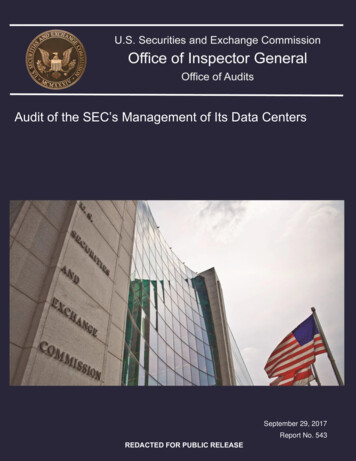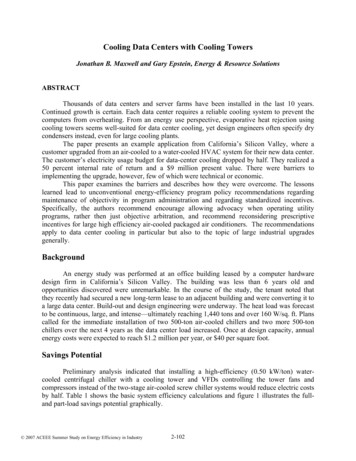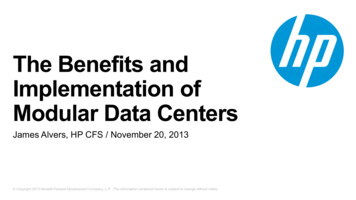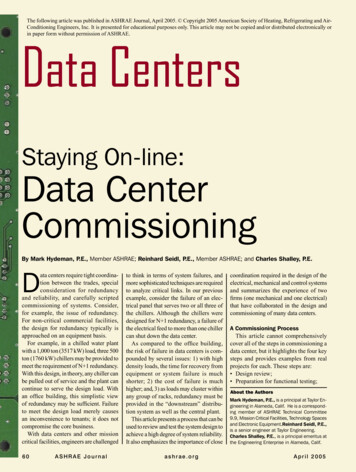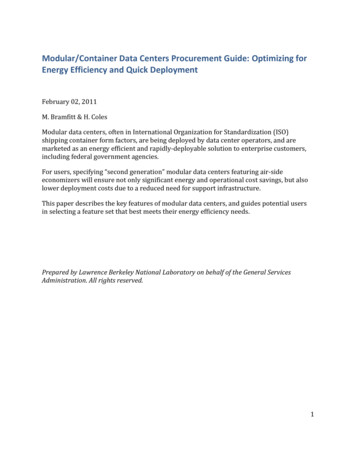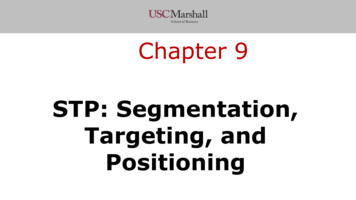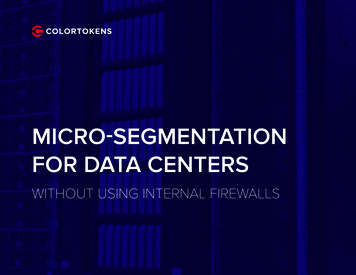
Transcription
MICRO-SEGMENTATIONFOR DATA CENTERSWITHOUT USING INTERNAL FIREWALLS
TABLE OF CONTENTSIntroduction3Your Perimeter Security is Rigid4Segmentation Using Internal Firewalls?7Micro-Segmentation Without Internal Firewalls9Conclusion12
INTRODUCTIONEvery day there’s a breach. Security leaders in enterprises are constantlyre-evaluating their strategies to defend from potential breaches. Yet, many arestill playing catch-up with the attackers that have gotten sophisticated. Giventhe many attack vectors and techniques used by the bad actors, and thefrequency of the attacks, cyber security has now become a boardroom topic.All these years, security has essentially remained reactive – looking for theknown bad or mitigating the threats after the damage is done. Remember, theattackers are getting smarter every day. So, what can you do?This paper will give you an idea on why data center micro-segmentationusing internal firewalls may not be the best way forward, and whya software-defined approach wins.Micro-Segmentation for Data Centers - Without Using Internal Firewalls-3-
YOUR PERIMETERSECURITY IS RIGIDEnterprises have evolved over the last decade – with hybrid data centers,and dynamic application and user environments. In a typical data center,almost 75% of the traffic flows East-West, and the rest North-South. Yet,enterprises have been relying heavily on perimeter firewalls to protect thedata centers.The perimeter is static. They have rigid policies focusing only on the trafficentering and leaving the data center - assuming the environment south ofthe perimeter is safe. Enterprise data centers today have workloads spreadacross a mix of bare metal, virtual machine, and multi-cloud infrastructures.Maintaining a consistent security policy in these environments is a bigchallenge using rigid perimeter security. Security teams have to do a lot ofheavy lifting to get minimal visibility using perimeter solutions. This limited/incomplete visibility puts a lot of pressure on the admins, resulting inmisconfigurations and inconsistent security postures.PERIMETER FIREWALLS ARE RIGID.Micro-Segmentation for Data Centers - Without Using Internal Firewalls-4-
Attackers are no more compromising the perimeter firewalls. They are morefocused on getting inside the data center through vulnerable endpoints through malware, phishing and social engineering attacks. In other words, theattacker is already inside the data center through compromised endpoints,exploring vulnerable ports on critical hosts and moving laterally (East-West)without getting detected.Insider Threats – The Insider Threat Report (2018) from CA Technologies saysthat 90% of the enterprises surveyed feel vulnerable to insider threats. This isdespite the organizations having several point security products like DLP, IAM,data encryption, endpoint protection, cloud access security and more.Remember, the insider attacks can be from malicious insiders misusing theircredentials to deliberately wreak havoc, or the unsuspecting users whosesystems have been compromised through phishing, malware and socialengineering techniques.PERIMETER FIREWALLSOLUTIONS ARE INEFFECTIVE INPROTECTING EAST-WEST TRAFFIC.Micro-Segmentation for Data Centers - Without Using Internal Firewalls-5-
In almost all the recent high-profile attacks, it took several days or evenmonths to detect the breach that had spread laterally, eventually exfiltratingsensitive data to the attacker’s command-and-control server. By the time theattacks get discovered, the damage has already been done – monetary lossand the subsequent damage to brand reputation.143 million accounts, 209,000 credit card numbers– Equifax Data Breach300,000 computers in 4 days– WannaCry Ransomware9.4 million passenger records– Cathay PacificAVERAGE DWELL TIME – 191 DAYS112018 Cost of a Data Breach Study by PonemonMicro-Segmentation for Data Centers - Without Using Internal Firewalls-6-
SEGMENTATION USINGINTERNAL FIREWALLS?Now that we know perimeter firewalls can’t secure East-West traffic, the otheroption is to protect the data center using internal firewalls. Internal firewallscan be used to segregate the data center into smaller segments and applyresource-access policies for the individual segments. Easier said than done.Note that today’s workloads are dynamic and continuously move from oneVLAN to the other - again, adds to the issue on how to manage the policies onthese workloads and keep them up-to-date when they move.Let’s say you want to implement environment separation for your applicationdevelopment segments in the data center. One of the most important goalshere will be to separate the production environment from development,testing and staging environment.You will deploy internal firewalls and create rules to make sure the productionenvironment remains isolated from the development, testing and stagingsegments. You will also create policies based on IP addresses and protocolsto define how this firewall should handle network traffic, aligning with yourenterprise information security policy requirements.CONGRATULATIONS!YOU JUST ADDED CHOKEPOINTS INYOUR NETWORK.Micro-Segmentation for Data Centers - Without Using Internal Firewalls-7-
INTERNAL SEGMENTATION USING FIREWALLS:DISADVANTAGESNetwork-centric approach - creates macro-segmentation insteadof micro-segmentationDoesn’t necessarily reduce the attack surfaceExtremely complex to achieve centralized visibility across on-premiseand multi-cloud data centersDifficult to have fine grained/micro policies at workload levelPolicies don’t move across environments when the resource movesDifficult to accomplish zero trust securityThousands of firewall rules – cumbersome and error-prone in dynamicdata centersVery expensive to procure and deploy multiple high-capacityinternal firewallsPerformance impact due to additional chokepointsVendor lock-in overheadMicro-Segmentation for Data Centers - Without Using Internal Firewalls-8-
MICRO-SEGMENTATIONWITHOUT INTERNALFIREWALLS – THE WAYFORWARDSoftware-defined micro-segmentation is the way forward to address thesecurity and operational challenges. One of the most notable advantagesof a software-defined approach is that it’s platform-agnostic, enablingmicro-segmentation to be implemented across data centers withoutvendor lock-in headache.Software-defined security, in general, is designed to span subnets, VLANs andfirewalls, enabling enterprises to manage security across multi-vendor hybridinfrastructures from a single central console. This will save you from dealingwith complex network-level constructs like IP addresses and thousands offirewall rules.In short, software-defined security works with the customers’ existinginfrastructure, without zero disruptions - achieves far better results withcomprehensive visibility, operational ease, and manageability.Micro-Segmentation for Data Centers - Without Using Internal Firewalls-9-
REDUCING THE ATTACK SURFACE:WHAT ELSE IS NEEDED?The end goal of data center segmentation is to reduce the attack surface andprotect the hosts (workloads) from cyber-attacks. Segmenting using internalfirewalls cannot achieve this completely.With software-defined micro-segmentation you can eradicate the gapbetween your enterprise’s desired security posture and the actual state ofsecurity, by enforcing resource access policies purely based on intent.In order to significantly reduce the attack surface, the micro-segmentationsolution must encompass the following:yy Threat Visibility - Granular visibility to understand the state of securityacross your data centeryy Intent-based Policies – Assess, measure and continuously improve thesecurity postureyy Residual Risk Metrics – Analyze and prioritize security tasks in conjunctionwith threat visibility and intent-based policiesThis is because in software-defined, micro-segmentation is done at the hostlevel, instead of at the network level.Micro-Segmentation for Data Centers - Without Using Internal Firewalls- 10 -
SHIFTING TO HOST-BASED SEGMENTATIONWith software-defined micro-segmentation, you can shift the segmentation tothe host, instead of segmenting at the network level. In other words, it’s akinto implementing perimeter security at every host.Typically, to make host-based micro-segmentation effective, it must includethe following capabilities:1. A single-pane-of-glass to manage, orchestrate and automate resourceaccess policies across dynamic application environments2. Leverage security features natively available on the workload3. Secure and monitor workloads no sooner than they are created4. Consistent security policies that follow the workload5. Built on zero trust security architecture6. Tamper-proof security policiesMicro-Segmentation for Data Centers - Without Using Internal Firewalls- 11 -
CONCLUSIONTraditional micro-segmentation techniques resided at the network level –making the security journey of an enterprise cumbersome, error-prone andineffective. Software-defined micro-segmentation is enabling enterprisesmake the paradigm shift towards accomplishing security that’s not reactive –simplifying the overall security journey.Host-based micro-segmentation reduces the attack surface and providesgranular control over the policies applied to dynamic applicationenvironments - irrespective of the operating system, underlying technologyand location of the workload. Software-defined micro-segmentation eliminatesthe need for expensive internal firewalls, enabling enterprises to protect thedata centers from sophisticated cyber threats.Micro-Segmentation for Data Centers - Without Using Internal Firewalls- 12 -
PROACTIVE SECURITY FORHYBRID DATA CENTERSAbout ColorTokensColorTokens is a Silicon Valley company, backed by legendary investors and advisors who have helped structure the IT industry over last 30 years. ColorTokens’ core teambrings deep and innovative industry experience from brands such as Cisco, Juniper, VMware, Microsoft, and Zscaler in domain areas including cybersecurity, networking, andinfrastructure. With customers and partners worldwide, ColorTokens is headquartered in Santa Clara (Silicon Valley), CA, USA with a major center of development and sales inBengaluru, India. 2019 ColorTokens, Inc. - All rights reserved.2101 Tasman Drive, Suite 201, Santa Clara, CA 95054 E: sales@colortokens.com P: 1 (408) 341-6030 www.colortokens.com
Micro-Segmentation for Data Centers - Without Using Internal Firewalls - 6 - Now that we know perimeter firewalls can’t secure East-West traffic, the other option is to protect the data center using internal firewalls.

